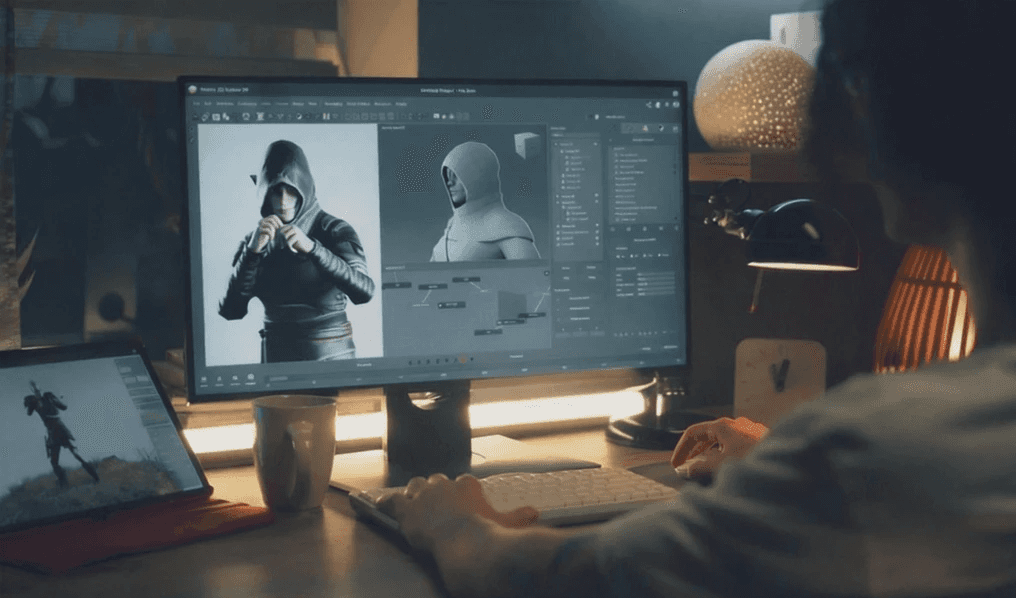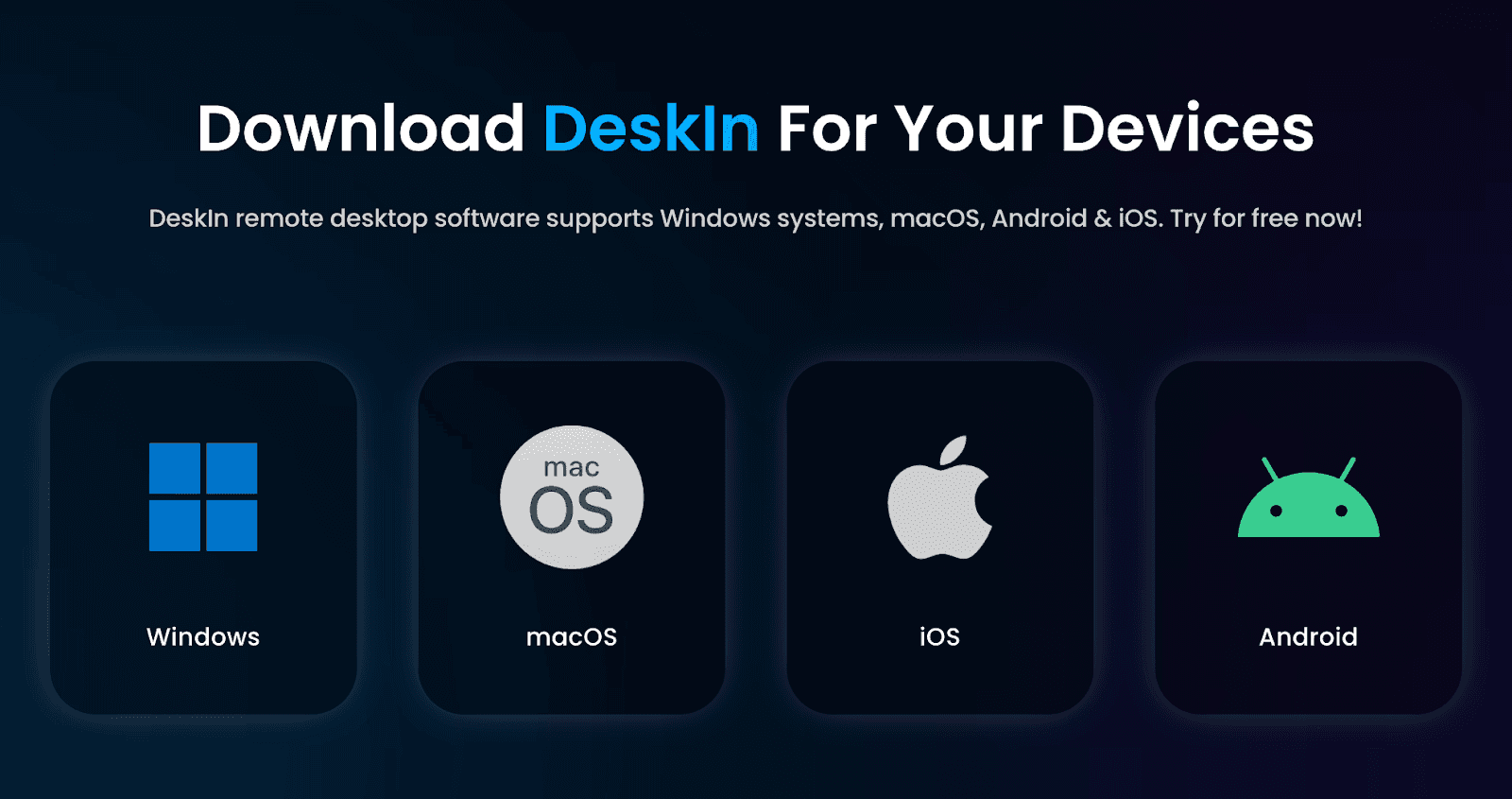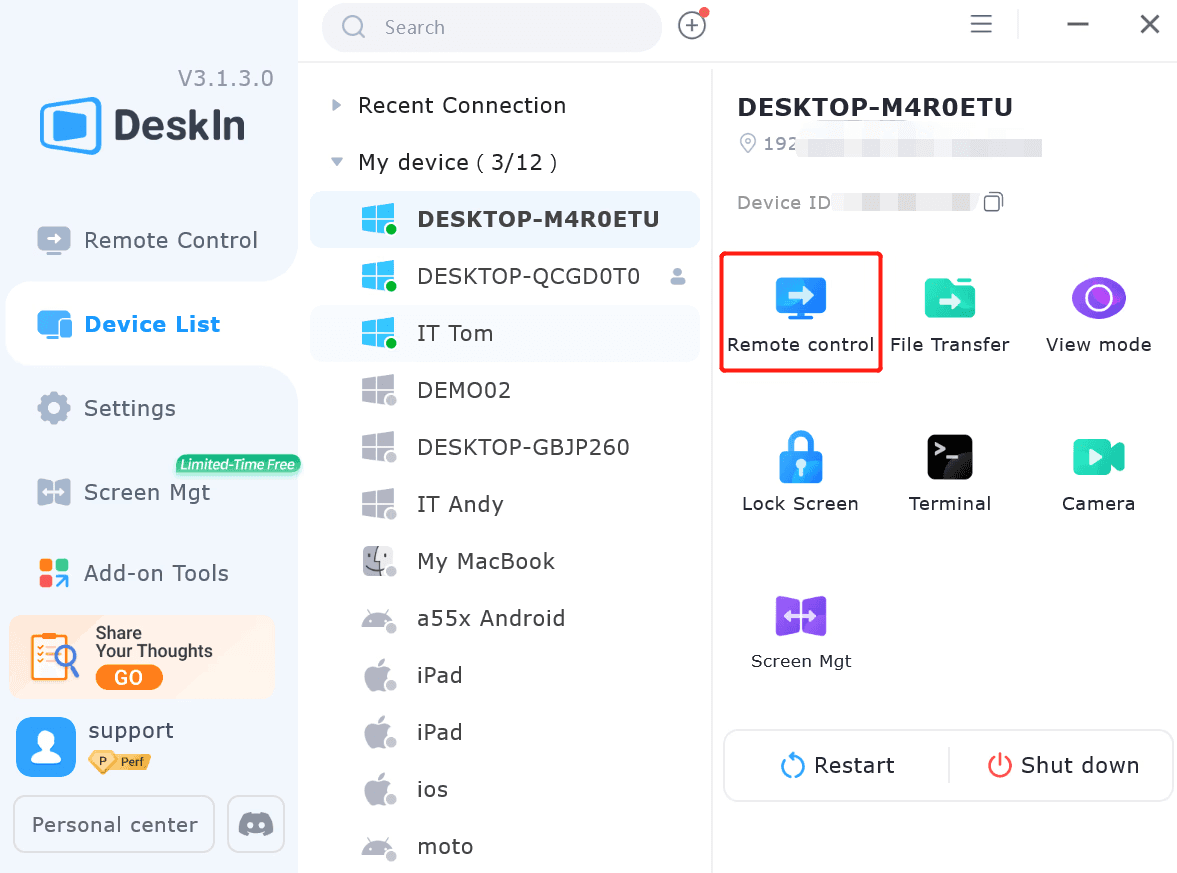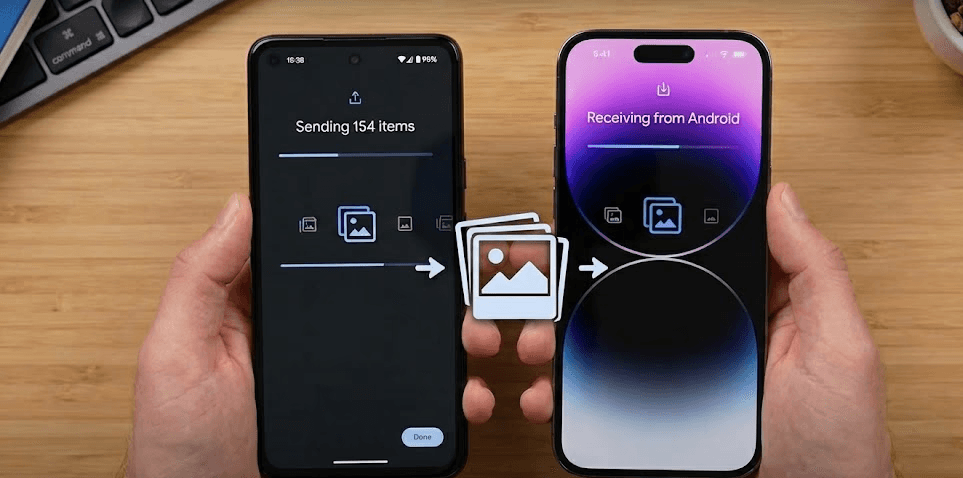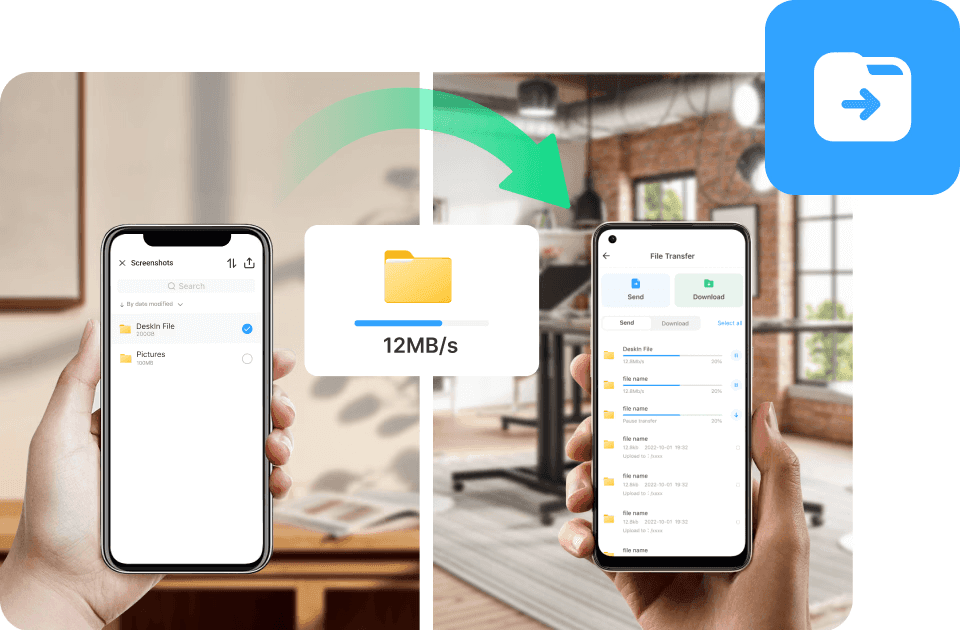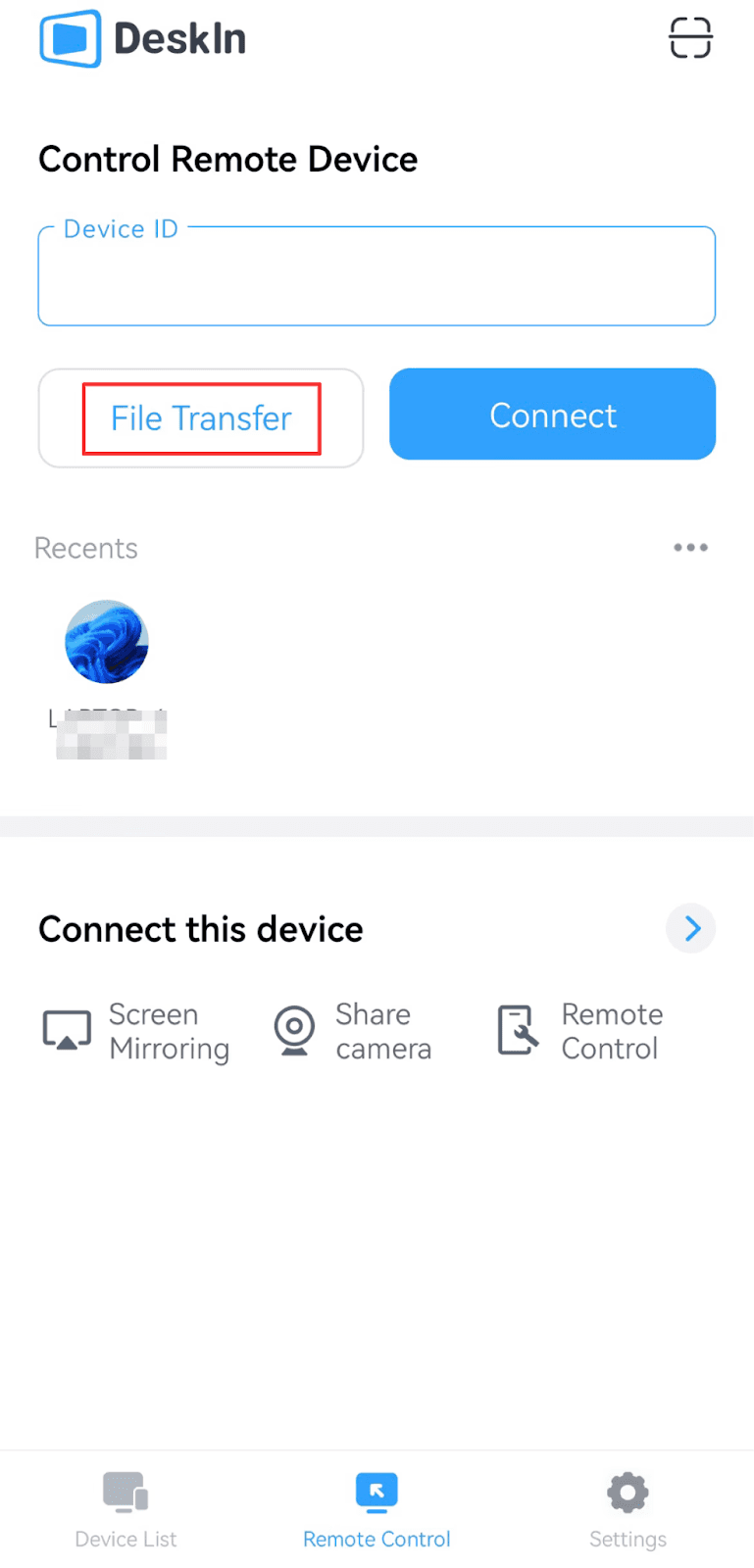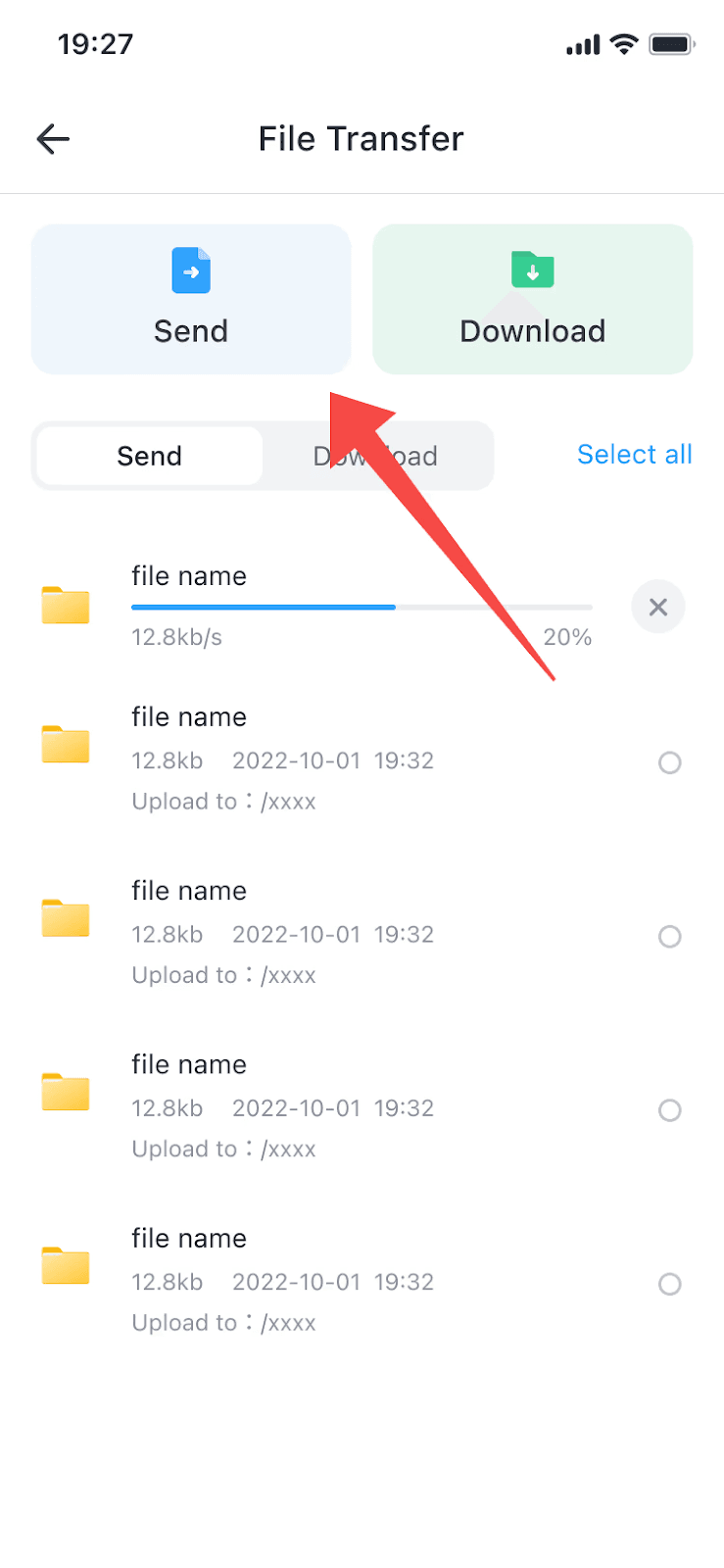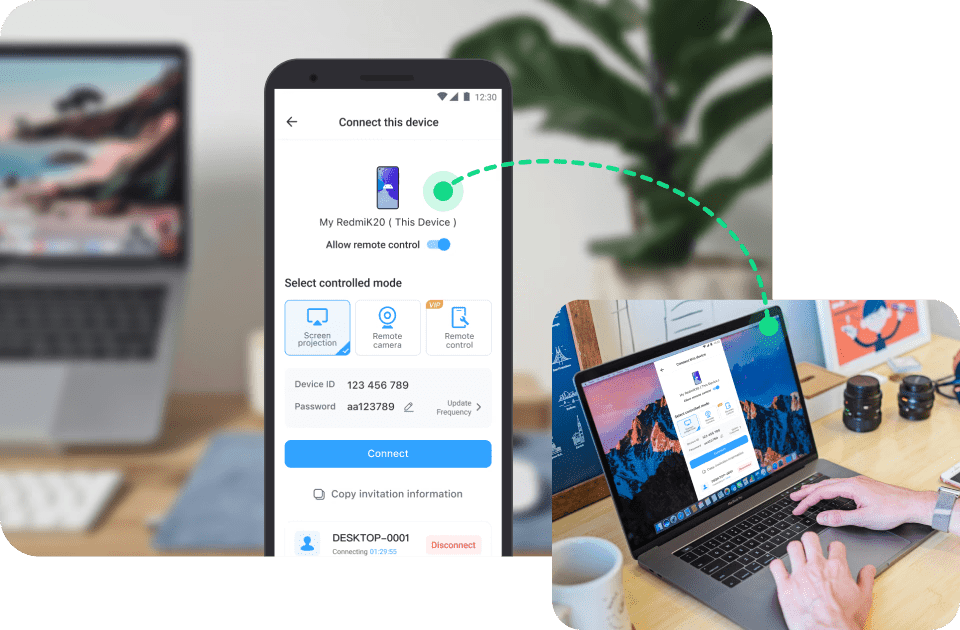If you've been using Microsoft's Remote Desktop app, you may have noticed some recent changes that raise questions about whether you're using the right version, or if something's gone wrong. Starting May 27, 2025, the Remote Desktop app will no longer be supported. Microsoft is replacing it with the new, unified Windows App, designed to offer better integration with services like Windows 365, Azure Virtual Desktop, and RemoteApp.
In this guide, we'll walk you through the Windows App, how to install it, use it effectively, and explore its key features. We'll also introduce an alternative solution, DeskIn, which could better fit your remote desktop needs depending on your specific use case.
👉 Click here to download DeskIn
You May Also Like:
Overview: Microsoft Remote Desktop vs. The Windows App

If you've been using Microsoft Remote Desktop on Mac, on Windows or any device, you might have noticed its recent name and functionality changes, since Microsoft has already released the unified Windows App on Mac's App Store. It reflects Microsoft's shift towards a more integrated platform that offers a comprehensive solution for connecting to Windows devices, virtual desktops, and cloud services.
This change has led to mixed references across forums, support pages, and download sources, leaving some users uncertain about whether they are using the correct version or if something has gone wrong during the installation process. As the Windows App becomes the standard tool, it's important to understand the differences and why this update is beneficial for remote desktop access.
You May Also Need:
What's the Difference?
For years, the Microsoft Remote Desktop app was the primary tool for connecting from macOS to Windows PCs. However, in 2024, Microsoft rebranded its remote desktop solution under the Windows App umbrella. The Windows App replaces the legacy Microsoft Remote Desktop client and introduces significant improvements, including enhanced integration with Windows 365, Azure Virtual Desktop, and other Microsoft services.
The good news is that, the new name, Windows App, is currently only effective for iOS/Android/Mac. For Windows users, you can still use the old version, Remote Desktop Connection. As the Microsoft Remote Desktop is shutting down, if you still want to enjoy the flexibility of remote control, it's advisable to make the switch to the Windows App for continued support, security updates, and access to newer features designed to improve your remote access experience.
Platform Support
The Windows App is now the go-to solution for remote desktop access across multiple platforms:
Windows
macOS
iOS/iPadOS. You can also use visionOS, but it's only supported in compatibility mode.
Android/Chrome OS
Web browsers
Connect to | Windows | macOS | iOS/ | Android/ | Web |
Azure Virtual Desktop | ✅ | ✅ | ✅ | ✅ | ✅ |
Windows 365 | ✅ | ✅ | ✅ | ✅ | ✅ |
Microsoft Dev Box | ✅ | ✅ | ✅ | ✅ | ✅ |
Remote Desktop Services | ❌ | ✅ | ✅ | ✅ | ❌ |
Remote PC | ❌ | ✅ | ✅ | ✅ | ❌ |
Note: To connect to Remote Desktop Services on Windows, continue to use the Remote Desktop app on Windows. And to connect to a remote PC on Windows, continue to use the Remote Desktop Connection app that comes with Windows (also known as MSTSC).
How to Use the Windows App for Remote Desktop Access
Now that you understand the difference between Microsoft Remote Desktop and the new Windows App, it's time to see how the updated experience works. Whether you're accessing a remote PC, logging into your Cloud PC from a tablet, or managing a virtual desktop in Azure, the Windows App simplifies the process with a more intuitive setup. Here's how to get started.
Step 1: Download the Windows App
To begin, you'll need to install the Windows App on your device. Fortunately, the Windows App for desktop is available across multiple platforms:
Windows: Available through the Microsoft Store.
macOS: Download via the Mac App Store.
iOS / iPadOS / Android: Available on the App Store and Google Play.
Web version: Access through supported browsers at "https://windows.cloud.microsoft".
If you're still searching for where to get the tool, just look for "Windows App download" in your device's app store or visit Microsoft's official website.

📌 Tips: Make sure your operating system meets the minimum requirements. On Windows, for example, you'll need Windows 10 version 1903 or later.
Step 2: Add a New Connection
Once installed, launch the Windows App and click "+ Add" to begin creating your first connection. You'll be prompted to choose from several connection types:
Remote PC: Enter the IP address or name of the Windows PC you want to control. This is ideal for one-on-one direct access.
Workspaces: These are pre-configured by your organization and can include virtual desktops or RemoteApp programs.
Cloud PC / Windows 365: Sign in with your Microsoft 365 account to access your cloud-hosted desktop.
Azure Virtual Desktop: For enterprise use, sign in with your work account to connect to virtual environments hosted on Azure.
After entering the required information, save the connection for quick access later.
Step 3: Connect and Control
Once your connection is set up, simply select it from your list and click "Connect". You'll be prompted to enter your credentials (if not saved earlier), and within seconds, you'll be controlling your remote environment.
You can interact with your remote PC just like you would on a local machine, open files, run apps, and even use multiple monitors (if supported). The Windows App also supports clipboard syncing, printer redirection, and dynamic resolution scaling for a seamless user experience.

[Bonus] Better Option to Replace the Windows App
While the Windows App offers a more modern and unified remote desktop experience, it may not suit everyone's needs. Some users find its setup a bit complex, especially when dealing with network configurations, cloud permissions, or multiple sign-in steps. If you're looking for a more straightforward, lightweight, and flexible alternative, DeskIn is worth considering.
DeskIn is an all-in-one remote access software that lets you connect two of your computers from anywhere, whether they are PCs or Macs, without the hassle of VPNs, corporate accounts, and cloud subscriptions. It's designed for personal users, freelancers, IT support professionals, and small businesses who need secure and fast remote access without the learning curve.
👉 Click here to download DeskIn.
Why Choose DeskIn over the Windows App:
Faster Setup: Download, install, and connect in minutes—no need to configure RDP ports or cloud workspace logins.
Cross-platform Support: Control Windows from Mac, iOS, Android, or another Windows PC effortlessly.
No Account Required (Optional Login): You can use DeskIn without registering, making it ideal for quick, one-time remote sessions.
High-Speed Performance: Optimized for low-latency connections even on slower networks.
Free for Personal Use: Unlike some remote solutions, DeskIn's version is completely free to use.
If you've decided to use DeskIn as an alternative method, follow these simple steps to get started:
STEP 1: Visit the official DeskIn download page and choose the version for your system (Windows or macOS).
STEP 2: Run the installer and open the application. No account is required, though you can log in for additional features.
STEP 3: To access a remote device, enter the DeskIn code displayed on the host computer. To be controlled, just share your DeskIn code with the person connecting.

STEP 4: Once the connection is established, you can instantly control the remote PC with full keyboard and mouse support, file transfer, and HD-quality screen sharing.
Whether you're accessing your home PC while traveling, helping a family member troubleshoot a device, or simply want a more intuitive alternative to the remote desktop Windows app, DeskIn gives you everything you need with less complexity.
Another Alternative: Chrome Remote Desktop
If you only need occasional remote access and want something simpler than DeskIn, Chrome Remote Desktop is another excellent lightweight option to consider. It's perfect for quick, one-off connections without heavy setup.
The Chrome Remote Desktop service runs directly in your Chrome browser, eliminating complex software installations. It's free, supports cross-platform access (Windows, macOS, Linux, Chrome OS, Android, iOS, Raspberry Pi), and imposes no device limits.
However, it lacks a built-in chat tool, doesn't blank the host's screen during sessions, and requires both parties to use the "same Google account". For Windows 10 users, start with the Chrome Remote Desktop App download for windows 10.
Step-by-Step Guide:
STEP 1: On the Windows 10 PC you want to access remotely, open Chrome, search "Chrome Remote Desktop", visit the official Chrome Web Store page, and install the "Chrome Remote Desktop" extension. Click "Turn on" under "Remote Access".
STEP 2: Set a secure PIN (at least 6 digits) when prompted and confirm. This enables remote connections to this host PC.

STEP 3: On your local device (any OS with Chrome or the mobile app), go to remotedesktop.google.com/access. Sign in with the same Google account used on the host PC.
STEP 4: Under "Remote Devices", select the host PC's name and enter the PIN you created in Step 2.
STEP 5: Click "Connect". You'll now control the remote Windows 10 desktop securely in your browser or app window.
FAQs About the Windows App for Remote Desktop
Will the old Remote Desktop app still work after May 2025?
No. Microsoft has officially announced that the classic Remote Desktop app will reach end-of-support on May 27, 2025. After this date, the app will no longer receive updates, security patches, or official support. While it may still function temporarily on some devices, continued use could expose you to potential security risks or compatibility issues, especially with newer Windows 10/11 updates.
To stay secure and benefit from improved cloud integration, users are strongly encouraged to switch to the Windows App for Remote Desktop, which supports features like Azure Virtual Desktop, Windows 365, and RemoteApp in a more seamless experience.
What is the Alternative to Windows Remote Desktop?
A powerful alternative is DeskIn. We recommend it for seamless cross-platform access to any Windows PC (old or new versions), Mac or mobile. DeskIn stands out with its simplicity, high-quality streaming, and zero cost for commercial use in its free plan. You get reliable, lag-free control without complex setup. For teams or individuals needing professional-grade remote access without licensing fees, DeskIn delivers.
Summary: Try the Windows App for Remote Desktop?
The Windows App for Remote Desktop is Microsoft's new standard, offering better integration, modern design, and cross-platform support. If you're still using the old Remote Desktop app, it's time to switch, especially with support ending in May 2025.
That said, if you want a more intuitive alternative, DeskIn is a great choice for faster setup and smoother remote access. Whether you go with the Windows App or explore another option like DeskIn, the key is finding a remote desktop solution that fits your workflow best. Ready to switch? Start with the Windows App download, test it out, and see if it meets your needs, or try DeskIn for a different, often more user-friendly approach.
If you've been using Microsoft's Remote Desktop app, you may have noticed some recent changes that raise questions about whether you're using the right version, or if something's gone wrong. Starting May 27, 2025, the Remote Desktop app will no longer be supported. Microsoft is replacing it with the new, unified Windows App, designed to offer better integration with services like Windows 365, Azure Virtual Desktop, and RemoteApp.
In this guide, we'll walk you through the Windows App, how to install it, use it effectively, and explore its key features. We'll also introduce an alternative solution, DeskIn, which could better fit your remote desktop needs depending on your specific use case.
👉 Click here to download DeskIn
You May Also Like:
Overview: Microsoft Remote Desktop vs. The Windows App

If you've been using Microsoft Remote Desktop on Mac, on Windows or any device, you might have noticed its recent name and functionality changes, since Microsoft has already released the unified Windows App on Mac's App Store. It reflects Microsoft's shift towards a more integrated platform that offers a comprehensive solution for connecting to Windows devices, virtual desktops, and cloud services.
This change has led to mixed references across forums, support pages, and download sources, leaving some users uncertain about whether they are using the correct version or if something has gone wrong during the installation process. As the Windows App becomes the standard tool, it's important to understand the differences and why this update is beneficial for remote desktop access.
You May Also Need:
What's the Difference?
For years, the Microsoft Remote Desktop app was the primary tool for connecting from macOS to Windows PCs. However, in 2024, Microsoft rebranded its remote desktop solution under the Windows App umbrella. The Windows App replaces the legacy Microsoft Remote Desktop client and introduces significant improvements, including enhanced integration with Windows 365, Azure Virtual Desktop, and other Microsoft services.
The good news is that, the new name, Windows App, is currently only effective for iOS/Android/Mac. For Windows users, you can still use the old version, Remote Desktop Connection. As the Microsoft Remote Desktop is shutting down, if you still want to enjoy the flexibility of remote control, it's advisable to make the switch to the Windows App for continued support, security updates, and access to newer features designed to improve your remote access experience.
Platform Support
The Windows App is now the go-to solution for remote desktop access across multiple platforms:
Windows
macOS
iOS/iPadOS. You can also use visionOS, but it's only supported in compatibility mode.
Android/Chrome OS
Web browsers
Connect to | Windows | macOS | iOS/ | Android/ | Web |
Azure Virtual Desktop | ✅ | ✅ | ✅ | ✅ | ✅ |
Windows 365 | ✅ | ✅ | ✅ | ✅ | ✅ |
Microsoft Dev Box | ✅ | ✅ | ✅ | ✅ | ✅ |
Remote Desktop Services | ❌ | ✅ | ✅ | ✅ | ❌ |
Remote PC | ❌ | ✅ | ✅ | ✅ | ❌ |
Note: To connect to Remote Desktop Services on Windows, continue to use the Remote Desktop app on Windows. And to connect to a remote PC on Windows, continue to use the Remote Desktop Connection app that comes with Windows (also known as MSTSC).
How to Use the Windows App for Remote Desktop Access
Now that you understand the difference between Microsoft Remote Desktop and the new Windows App, it's time to see how the updated experience works. Whether you're accessing a remote PC, logging into your Cloud PC from a tablet, or managing a virtual desktop in Azure, the Windows App simplifies the process with a more intuitive setup. Here's how to get started.
Step 1: Download the Windows App
To begin, you'll need to install the Windows App on your device. Fortunately, the Windows App for desktop is available across multiple platforms:
Windows: Available through the Microsoft Store.
macOS: Download via the Mac App Store.
iOS / iPadOS / Android: Available on the App Store and Google Play.
Web version: Access through supported browsers at "https://windows.cloud.microsoft".
If you're still searching for where to get the tool, just look for "Windows App download" in your device's app store or visit Microsoft's official website.

📌 Tips: Make sure your operating system meets the minimum requirements. On Windows, for example, you'll need Windows 10 version 1903 or later.
Step 2: Add a New Connection
Once installed, launch the Windows App and click "+ Add" to begin creating your first connection. You'll be prompted to choose from several connection types:
Remote PC: Enter the IP address or name of the Windows PC you want to control. This is ideal for one-on-one direct access.
Workspaces: These are pre-configured by your organization and can include virtual desktops or RemoteApp programs.
Cloud PC / Windows 365: Sign in with your Microsoft 365 account to access your cloud-hosted desktop.
Azure Virtual Desktop: For enterprise use, sign in with your work account to connect to virtual environments hosted on Azure.
After entering the required information, save the connection for quick access later.
Step 3: Connect and Control
Once your connection is set up, simply select it from your list and click "Connect". You'll be prompted to enter your credentials (if not saved earlier), and within seconds, you'll be controlling your remote environment.
You can interact with your remote PC just like you would on a local machine, open files, run apps, and even use multiple monitors (if supported). The Windows App also supports clipboard syncing, printer redirection, and dynamic resolution scaling for a seamless user experience.

[Bonus] Better Option to Replace the Windows App
While the Windows App offers a more modern and unified remote desktop experience, it may not suit everyone's needs. Some users find its setup a bit complex, especially when dealing with network configurations, cloud permissions, or multiple sign-in steps. If you're looking for a more straightforward, lightweight, and flexible alternative, DeskIn is worth considering.
DeskIn is an all-in-one remote access software that lets you connect two of your computers from anywhere, whether they are PCs or Macs, without the hassle of VPNs, corporate accounts, and cloud subscriptions. It's designed for personal users, freelancers, IT support professionals, and small businesses who need secure and fast remote access without the learning curve.
👉 Click here to download DeskIn.
Why Choose DeskIn over the Windows App:
Faster Setup: Download, install, and connect in minutes—no need to configure RDP ports or cloud workspace logins.
Cross-platform Support: Control Windows from Mac, iOS, Android, or another Windows PC effortlessly.
No Account Required (Optional Login): You can use DeskIn without registering, making it ideal for quick, one-time remote sessions.
High-Speed Performance: Optimized for low-latency connections even on slower networks.
Free for Personal Use: Unlike some remote solutions, DeskIn's version is completely free to use.
If you've decided to use DeskIn as an alternative method, follow these simple steps to get started:
STEP 1: Visit the official DeskIn download page and choose the version for your system (Windows or macOS).
STEP 2: Run the installer and open the application. No account is required, though you can log in for additional features.
STEP 3: To access a remote device, enter the DeskIn code displayed on the host computer. To be controlled, just share your DeskIn code with the person connecting.

STEP 4: Once the connection is established, you can instantly control the remote PC with full keyboard and mouse support, file transfer, and HD-quality screen sharing.
Whether you're accessing your home PC while traveling, helping a family member troubleshoot a device, or simply want a more intuitive alternative to the remote desktop Windows app, DeskIn gives you everything you need with less complexity.
Another Alternative: Chrome Remote Desktop
If you only need occasional remote access and want something simpler than DeskIn, Chrome Remote Desktop is another excellent lightweight option to consider. It's perfect for quick, one-off connections without heavy setup.
The Chrome Remote Desktop service runs directly in your Chrome browser, eliminating complex software installations. It's free, supports cross-platform access (Windows, macOS, Linux, Chrome OS, Android, iOS, Raspberry Pi), and imposes no device limits.
However, it lacks a built-in chat tool, doesn't blank the host's screen during sessions, and requires both parties to use the "same Google account". For Windows 10 users, start with the Chrome Remote Desktop App download for windows 10.
Step-by-Step Guide:
STEP 1: On the Windows 10 PC you want to access remotely, open Chrome, search "Chrome Remote Desktop", visit the official Chrome Web Store page, and install the "Chrome Remote Desktop" extension. Click "Turn on" under "Remote Access".
STEP 2: Set a secure PIN (at least 6 digits) when prompted and confirm. This enables remote connections to this host PC.

STEP 3: On your local device (any OS with Chrome or the mobile app), go to remotedesktop.google.com/access. Sign in with the same Google account used on the host PC.
STEP 4: Under "Remote Devices", select the host PC's name and enter the PIN you created in Step 2.
STEP 5: Click "Connect". You'll now control the remote Windows 10 desktop securely in your browser or app window.
FAQs About the Windows App for Remote Desktop
Will the old Remote Desktop app still work after May 2025?
No. Microsoft has officially announced that the classic Remote Desktop app will reach end-of-support on May 27, 2025. After this date, the app will no longer receive updates, security patches, or official support. While it may still function temporarily on some devices, continued use could expose you to potential security risks or compatibility issues, especially with newer Windows 10/11 updates.
To stay secure and benefit from improved cloud integration, users are strongly encouraged to switch to the Windows App for Remote Desktop, which supports features like Azure Virtual Desktop, Windows 365, and RemoteApp in a more seamless experience.
What is the Alternative to Windows Remote Desktop?
A powerful alternative is DeskIn. We recommend it for seamless cross-platform access to any Windows PC (old or new versions), Mac or mobile. DeskIn stands out with its simplicity, high-quality streaming, and zero cost for commercial use in its free plan. You get reliable, lag-free control without complex setup. For teams or individuals needing professional-grade remote access without licensing fees, DeskIn delivers.
Summary: Try the Windows App for Remote Desktop?
The Windows App for Remote Desktop is Microsoft's new standard, offering better integration, modern design, and cross-platform support. If you're still using the old Remote Desktop app, it's time to switch, especially with support ending in May 2025.
That said, if you want a more intuitive alternative, DeskIn is a great choice for faster setup and smoother remote access. Whether you go with the Windows App or explore another option like DeskIn, the key is finding a remote desktop solution that fits your workflow best. Ready to switch? Start with the Windows App download, test it out, and see if it meets your needs, or try DeskIn for a different, often more user-friendly approach.







